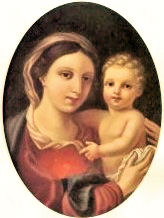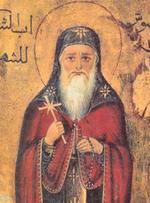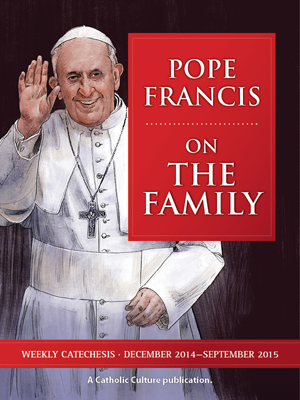History of Our Lady of Trust
by Unknown
Pope Benedict XVI speaking to the community of the Roman Major Seminary on the feast of Our Lady of Trust said, "It really is very beautiful and meaningful that you venerate the Virgin Mary, Mother of Priests, with the special title of Our Lady of Trust. It evokes a twofold meaning: the trust of the Seminarians who, with her help, set out on their journey in response to Christ who has called them, and the trust of the Church of Rome, especially that of her Bishop, which invokes the protection of Mary, the Mother of every vocation, upon this nursery-garden of priests." (Read the Address)
Timeline
- The picture of Our Lady of Confidence was painted by the great Italian painter Carlo Maratta (1625-1713) who was knighted by Pope Clement XI in 1704 and made court painter by Louis XIV the same year.
- Maratta gave the picture to a noblewoman, Clair Isabella Fornari (June 25 1697- December 9, 1744), the Abbess of the Convent of Poor Claire of St. Francis in the city of Todi.
- The Abbess – today the Venerable Sister Clair Isabel Fornari – embraced a life of severe penance and was favored with many mystical graces. She had a great devotion to sacred images, especially those of Mary. She treasured the picture Maratta gave her and would meditate on it during her prayer time.
- Our Lady promised Sister Clair that she would give special graces to all those throughout the ages who would venerate the image of our Lady of Trust. “My Heavenly Mother assured me,” said the Abbess, “that she would give a special tenderness and devotion toward her to everyone who contemplated this image” (the original and copies).
- Sister Clair advised her spiritual director, Father Gazali, to take the picture with him whenever he traveled. Father Gazali always found a great sense of peace and consolation from it. He kept the picture until his death (July 29, 1762). After this his possessions, including the image, were given to the Sisters of the Monastery of St. Francis of Todi where they are today.
- In the Major Seminary in Rome there is an identical picture of our Lady of Confidence. How can this be? Sister Clair had another spiritual advisor, Father Crivelli, who was the spiritual director of the German College in Rome. While visiting Foligno, Father Crivelli became seriously sick, but was suddenly healed as soon as Sister sent him the original painting. He was so moved by this healing that he wanted a copy of the image, which he took to Rome and then to the local seminary. From this simple beginning the devotion spread so that by the 1830’s Our Lady of Trust had become the patroness of the Major Seminary in Rome.
- Our Lady of Trust protected the seminarians in times of crisis. In 1837, the scourge of Asiatic flu claimed many lives. The seminarians and their families were put under the protection of Mary; not one of them contracted the disease! In thanksgiving, two crowns were fashioned in gold and placed on the images of Mary and the Child Jesus.
- During World War I, more than 100 seminarians were forced into the Italian military. The seminarians placed themselves under the special care of Mary of Trust. They all returned home safely. To repay the goodness of their Queen, the seminarians put diadems on the crowns of Mother and Child!
- The devotion to Our Lady of Trust has spread worldwide. The Feast of Our Lady of Trust is celebrated on the Saturday before Ash Wednesday.
Mary, Our Lady of Trust
 Our Lady of Trust is the Madonna of tenderness. Mary receives and accepts the enthusiastic embrace of the Baby who with His right arm tenderly clasps His mother’s neck and with His left points to her heart.
Our Lady of Trust is the Madonna of tenderness. Mary receives and accepts the enthusiastic embrace of the Baby who with His right arm tenderly clasps His mother’s neck and with His left points to her heart.
The focal point of the composition is the space between the faces of Jesus and Mary and between their hearts. This space is an iconographic representation of the "Breath" of the Holy Spirit that rests on the Word made man, the Son of Mary, and that is poured out upon us.
The dark background of the painting represents the dimension of the divine that goes beyond time and space. The flowing robes of our Lady with their vibrant colors convey the honor that is given to her as the Theotokos, the God-bearer. The blue mantle symbolizes the Divinity; the red dress identifies Mary as the Mother of God; and the white scarf around Mary’s neck represents her acceptance of the mystery of salvation and the plan of God. Although the Baby Jesus is naked, He is warmed by the reassuring arms of His mother who wraps and covers Him with the white cloth.
In its strong yet gentle features, the face of the Theotokos is the face of Mother Church generating and molding God’s people into the image of her Son. In the heart of every person, in joyful moments as in sorrowful ones, two old affections are associated; two dear words are united to each other: Mother and Trust. These two words intertwine almost instinctively in a prayer: My Mother, My Confidence!
Giuliana Spigone!
Prayer to Our Lady of Trust written by Bishop William Giaquinta
This item 6825 digitally provided courtesy of CatholicCulture.org






